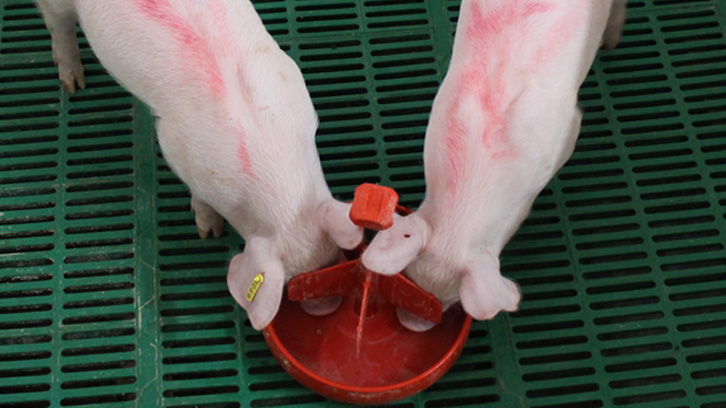Pleasure during food consumption in pigs: a new proposal of study

In pigs, the palatability of different feeds or solutions has typically been inferred indirectly from measurements of preference or acceptance. However, these measures provide weak evidence of pigs’ hedonism. Critically, consumption is not the same as palatability, especially where high nutrient concentrations can promote satiety while palatability measures continue to increase. In addition, preference tests are limited by the possibility of interactions between options as well as by effects of choice time on observed preferences. Despite recent interest in pigs’ feeding behavior there is little information about methods for estimating pigs’ hedonic reactions.
A total of 48 male and female 42d-old pigs were exposed in pairs to different sucrose (Exp. 1) or Monosodium Glutamate (MSG, Exp. 2) solutions over seven consecutive 10 min. tests (one concentration/day). Palatability was estimated through consumption patterns (consumption time/approaches) analogous to the lick cluster size analysis used in rats; Orofacial expressions (snout openings and tongue protrusions) and by estimating their consumption during the first 2 min of the test.
Consumption was affected by sucrose showing an inverted-U function relative its concentration with the highest responses at intermediate levels of 4 and 8%. Consumption patterns were positively related to sucrose concentration. Brief consumption time was not related with sucrose concentration. Snout openings were higher when the higher concentrations were delivered. However, tongue protrusions were not affected by sucrose concentration. MSG concentration affected consumption and consumption patterns observing positive correlations in both. Brief consumption time was influenced by MSG concentration also producing a positive correlation. Animals did not present tongue protrusions at any concentration and MSG concentration affected snout openings with a positive correlation between them.
As Michael Forbes notes, palatability is a complex concept, which depends on several variables, both internal and external to the animal. This experiment demonstrates the limitations of using simple consumption measures as an indication of palatability and suggests that consumption patterns might represent a valuable measure for hedonic assessment in pigs. The fact that palatability can be dissociated from consumption may be important for the formulation of diets in industry: consumption may be reduced by high-palatability additives that also contribute to satiety. Moreover, the fact that changes in the internal state of rodents through learning or stress can selectively influence these hedonic measures, also raises the possibility that the analysis of consumption patterns in pigs may offer a valuable tool for identification of hedonic changes after learning or hedonic dysfunctions related to welfare problems.
Pontificia Universidad Católica de Chile
2) Food and Animal Science Department
Universitat Autònoma de Barcelona
References
Jaime Figueroa, Daniela Frías, David Solà-Oriol, Tamara Tadich, Rosa Franco-Rosselló, Valentina Nuñez, Dominic M Dwyer. Palatability in pigs, the pleasure of consumption. Journal of Animal Science, Volume 97, Issue 5, May 2019, Pages 2165–2174, https://doi.org/10.1093/jas/skz085
- Clouard, C., M. Chataignier, M.C. Meunier-salaün, and D. Val-Laillet. 2012. Flavour preference acquired via a beverage-induced conditioning and its transposition to solid food: sucrose but not maltodextrin or saccharin induced significant flavour preferences in pigs. Appl. Anim. Behav. Sci. 136:26–36. Doi.org/10.1016/j.applanim.2011.11.007
- Dwyer, D. M. 2012. Licking and liking: The assessment of hedonic responses in rodents. Q. J. Exp. Psychol. 65:371–394. Doi:10.1080/17470218.2011.652969
- Figueroa, J., D. Solà-Oriol, E. Borda, A. Sclafani, and J.F. Pérez. 2012. Flavour preferences conditioned by protein solutions in post-weaning pigs. Physiol. Behav. 107:309–316. Doi:10.1016/j.physbeh.2012.08.008
- Forbes, J. M. 2010. Palatability: principles, methodology and practice for farm animals. J. Anim. Sci. 229-243. Doi: 10.1079/PAVSNNR20105052
- Myers, K. P., and Sclafani, A. 2001. Conditioned enhancement of flavor evaluation reinforced by intragastric glucose: II. Taste reactivity analysis. Physiol. Behav. 74: 495-505. Doi.org/10.1016/S0031-9384(01)00596-0
- Oostindjer, M., J. E. Bolhuis, M. Mendl, S. Held, H. van den Brand, and B. Kemp. 2011. Learning how to eat like a pig: effectiveness of mechanisms for vertical social learning in piglets. Anim Behav. 82: 503-511. Doi.org/10.1016/j.anbehav.2011.05.031


